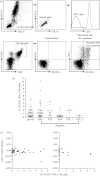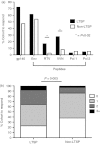Specific antibody-dependent cellular cytotoxicity responses associated with slow progression of HIV infection
- PMID: 23173935
- PMCID: PMC3575764
- DOI: 10.1111/imm.12016
Specific antibody-dependent cellular cytotoxicity responses associated with slow progression of HIV infection
Abstract
Antibody-dependent cellular cytotoxicity (ADCC) is potentially an effective adaptive immune response to HIV infection. However, little is understood about the role of ADCC in controlling chronic infection in the small number of long-term slow-progressors (LTSP) who maintain a relatively normal immunological state for prolonged periods of time. We analysed HIV-specific ADCC responses in sera from 139 HIV(+) subjects not on antiretroviral therapy. Sixty-five subjects were LTSP, who maintained a CD4 T-cell count > 500/μl for over 8 years after infection without antiretroviral therapy and 74 were non-LTSP individuals. The ADCC responses were measured using an natural killer cell activation assay to overlapping HIV peptides that allowed us to map ADCC epitopes. We found that although the magnitude of ADCC responses in the LTSP cohort were not higher and did not correlate with CD4 T-cell depletion rates, the LTSP cohort had significantly broader ADCC responses compared with the non-LTSP cohort. Specifically, regulatory/accessory HIV-1 proteins were targeted more frequently by LTSP. Indeed, three particular ADCC epitopes within the Vpu protein of HIV were recognized only by LTSP individuals. Our study provides evidence that broader ADCC responses may play a role in long-term control of HIV progression and suggests novel vaccine targets.
© 2012 The Authors. Immunology © 2012 Blackwell Publishing Ltd.
Figures



References
-
- Rerks-Ngarm S, Pitisuttithum P, Nitayaphan S, et al. Vaccination with ALVAC and AIDSVAX to prevent HIV-1 infection in Thailand. N Engl J Med. 2009;361:2209–20. - PubMed
-
- Karnasuta C, Paris RM, Cox JH, et al. Antibody-dependent cell-mediated cytotoxic responses in participants enrolled in a phase I/II ALVAC-HIV/AIDSVAX B/E prime-boost HIV-1 vaccine trial in Thailand. Vaccine. 2005;23:2522–9. - PubMed
-
- Gomez-Roman VR, Patterson LJ, Venzon D, Liewehr D, Aldrich K, Florese R, Robert-Guroff M. Vaccine-elicited antibodies mediate antibody-dependent cellular cytotoxicity correlated with significantly reduced acute viremia in rhesus macaques challenged with SIVmac251. J Immunol. 2005;174:2185–9. - PubMed
-
- Xiao P, Zhao J, Patterson LJ, et al. Multiple vaccine-elicited nonneutralizing antienvelope antibody activities contribute to protective efficacy by reducing both acute and chronic viremia following simian/human immunodeficiency virus SHIV89.6P challenge in rhesus macaques. J Virol. 2010;84:7161–73. - PMC - PubMed
Publication types
MeSH terms
Substances
Grants and funding
LinkOut - more resources
Full Text Sources
Other Literature Sources
Medical
Research Materials

